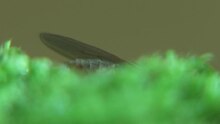Barn flies
| Barn flies | ||||||||||||
|---|---|---|---|---|---|---|---|---|---|---|---|---|

Suillia sp. |
||||||||||||
| Systematics | ||||||||||||
|
||||||||||||
| Scientific name | ||||||||||||
| Heleomyzidae | ||||||||||||
| Bezzi , 1911 | ||||||||||||
| Subfamilies | ||||||||||||
The barley flies (Heleomyzidae), also known as dark flies , are a family of the two-winged flies ( Diptera) and belong to the flies (Brachycera). Around 500 species of this group of animals live worldwide, 62 of which are known from Germany. They are all small to medium-sized flies with a body length of 1.5 to 12 millimeters.
features
The barn flies are mostly yellow-red, brown or black. A striking feature are the very strong tactile bristles in the mouth area and the edge of the wing, which, in addition to strong bristles, is often also heavily thorn.
Way of life
The flies are particularly common on shady bushes or other vegetation. Also on carrion , excrement , tree wounds, mushrooms or on mostly umbel- like flowers. Some species are also found in apartments, stables, caves or in the living quarters of mammals . Sometimes you can find the flies even in winter down to minimum temperatures of minus 12 ° C.
Larval development
The larvae have a typical maggot shape with thorny creeping bulges. They often live in decomposing plant remains and animal matter. Species of the genera Heleomyza and Scoliocentra live as coprophages in excrement (also in caves in bat excrement or in chicken excrement ( Heleoymza serrata )), others on carrion ( necrophagy ) or fungi. The latter includes the truffle fly ( Suillia tuberiperda ), whose larvae live in truffles and whose search behavior for underground truffles is used by some truffle hunters. Some species also live as pests on cultivated plants, such as the garlic fly ( Suillia univittata ) on garlic.
Fossil evidence
Fossil evidence of this family of insects is rare and comes exclusively from tertiary deposits. For example, representatives of at least seven genera have been identified from the Eocene Baltic amber . Scheufflies are also found in the somewhat younger Dominican amber .
Types (selection)
literature
- K. Honomichl, H. Bellmann: Biology and ecology of insects ; CD-Rom, Gustav Fischer Verlag, Stuttgart 1994.
Web links
Individual evidence
- ↑ George O. Poinar, Jr .: Life in Amber . 350 pp., 147 figs., 10 plates, Stanford University Press, Stanford (Cal.) 1992. ISBN 0-8047-2001-0
- ↑ http://hbs.bishopmuseum.org/fossilcat/fossheleomyzidae.html fossil Diptera
